
|

|
|
Home Site Search Contact Us Subscribe
|
|
INSIGHT: A Focus on Local: Structure and Design of the Columbus Museum of Art Expansion How DesignGroup worked with the museum to become more visible, relevant, and connected to the community as a meeting point between art, the public, and the physical city. By Michael Bongiorno, AIA, LEED AP BD+C May 22, 2015 The Columbus Museum of Art (CMA) serves as a thriving inspiration center for the community and does many things well. It provides contemplative moments, creates learning opportunities for all ages, hosts weddings and corporate events, and provides space for innovation. Above all else, it presents and protects the collection.
While CMA has benefitted the community in many ways since 1931, the museum leadership knew it could do much more, and at a higher level. With an expanding collection and a growing local population eager for more engagement, the museum aspired to develop a major expansion project in complete alignment with its mission: creating great experiences with great art for everyone.
To that end, the CMA engaged DesignGroup, a local architecture and design firm noted for its high-profile, community-impacting projects throughout the Central Ohio region, to realize the museum’s vision of a project that directly reflects the personality of the immediate and broader community, both physically and culturally. DesignGroup’s offices are located steps away, within the city’s Discovery District, making the project staff available at a moment’s notice. This proximity and availability was exactly the level of service the museum required of its architect.
This expansion of the CMA, the third phase of a three-part master plan, consists of a 50,000-square-foot addition, renovation of the 38,000-square-foot 1974 wing, and associated site work related to a new main entrance, new sculpture garden, and other outdoor spaces.
The Context The Columbus Museum of Art sits within multiple contexts. Situated prominently on Broad Street, a historically significant east-west thoroughfare, it resides within the immediate context of the designated “Creative Campus” which includes the Columbus College of Art and Design (CCAD) and Columbus State Community College. This Creative Campus sits within the broader context of the “Discovery” Special Improvement District, which includes the aforementioned neighbors, as well as the Columbus Metropolitan Main Library, Capital University Law School, and Franklin University. Also located along Broad Street are two other major cultural and educational institutions: The Franklin Park Conservatory and The Center of Science and Industry. The museum regularly collaborates with all of these neighboring institutions.
These contexts are also defined by a number of physical and material characteristics that the new addition reflects: the limestone and bronze of the museum’s 1931 Ross Wing, the patinated copper roofs and spires of the First Congregation Church, the green serpentine stone of the Broad Street United Methodist Church, and the dynamic, contemporary architecture of the CCAD.
Mission-centered Design DesignGroup asked a series of provocative questions of CMA about both the relationship of the museum to contemporary culture, and the museum’s physical relationship to the city and its citizens. The building design is a reflection of the answers to the questions, in addition to CMA’s stated ambition to be more visible, relevant, and connected to the community as a meeting point between art, the public, and the physical city. CMA is changing and adapting to a new age – away from a “hallowed hall” and toward an experience for visitors of all ages who come to enjoy the collection and to socialize. It was the museum’s desire to create a place without barriers, where people from all walks of life could come to “hang out.” This places the CMA at the vanguard of a new movement among art museums that focuses not only on art, but also on visitors and their experiences with art and with each other. In doing so, they are capturing an audience that may be overlooked and that may have overlooked the museum in the past.
The Addition The design concept is simple: a long bar of gallery space on the east side of the site is separated from the Ross Wing by a sky-lit concourse and entry forecourt, which serve as the central organizing element of the project. The purpose of the concourse, in addition to acting as a hyphen between the historic wing and new addition, is multi-fold: a lobby, a cueing space, an event space, a meeting point, and a circuit to connect to multiple program elements. A series of bridges at the second floor crosses the concourse and connects the new galleries to the existing building. Recognizing that the Ross Wing is a beloved community icon, the new addition maintains the visual integrity of the original building exterior to the greatest degree possible. The addition will have a very different, but complimentary, design to the Ross Wing. From an architectural perspective, the original building is a historic jewel, and the wing will be more of a setting that highlights its beauty.
The museum’s presence to the north and south is announced through “cinematic façades” – floor-to-ceiling glass walls filling the entirety of the north and south face of the galleries. These façades are critical gestures that engage the surrounding context; on the one hand, they allow a view of activity within to the passerby; on the other hand, the museum visitor, once inwardly focused, is now able to look out to the city.
A new special event space, axially related to the historic Derby Court event space in the Ross Wing, sits on the second floor, overlooking the sculpture garden to the north. The sculpture garden is then accessed by stair from an outdoor balcony serving the special event space. The net effect of this event “spine” is that it can create a seamless experience beginning at the ceremonial Broad Street entry of the historic wing and ending at the new sculpture garden.
Semi-public Spaces and Gardens The entry forecourt is a gently sloping covered walk defined by, and accessing, the new sculpture garden to the west and a green space along Washington Avenue to the east. It serves as the museum’s main entrance. Semi-public program elements such as the retail store and café are strategically located with relation to this forecourt and other outdoor spaces to provide the most ground-floor activation possible. Large folding glass wall panels allow the café to be fully opened to a terrace that overlooks the sculpture garden.
The new sculpture and event garden is designed to accommodate the museum’s compelling collection of outdoor works, in addition to events and dining. The Washington Avenue lawn is a tree-lined green space that serves the entry forecourt, and will be the location of an iconic sculpture. The integration of these terraces, gardens, balconies, and related elements offers seamless, unwinding gallery experiences and total immersion in the museum’s collection.
In the back-of-house, the design team has accommodated a new fully-enclosed, air-conditioned, and secure art loading dock necessary for the museum to receive significant loaned works in the future. Both a full-service and catering kitchen are located on the second floor, adjacent to the new event space. Other areas provide art storage and event support.
Materials Use The building structure is a combination of cast-in-place, post-tensioned concrete, concrete masonry walls, and structural steel. The project realized an enormous amount of cost savings by maintaining the cast-in-place frame of the 1974 wing, as well as its substantial art transport elevator.
On the building exterior, time-honored and context-specific materials are used in new ways. Materials include Zahner’s pre-patinated “Star Blue” copper, Indiana limestone, and Kawneer 1600 Ultra-Thermal curtainwall glazing. A durable building water table of Cold Springs “Charcoal Gray” granite also serves as exterior pavement within the forecourt and garden, as well as the flooring in the entry concourse.
The copper is deployed on the upper gallery using a proprietary Keith Panel reveal system arranged in a pattern scripted by DesignGroup. Certain panels are perforated and screen a discreet light source that changes the character of the building in the evening. Strategically placed glazing and roof monitors are intended to create both framed views and opportunities for natural lighting. Acoustics in the event space are controlled with Vogl “Decken Systeme” perforated acoustic drywall panels. Much of the exterior wall materials are continued into the building’s interior.
Ambitious Sustainability The project is pursuing LEED Silver certification. Some sustainable features of note include lighting comprised entirely of LED fixtures; the use of high-performance exterior envelope assemblies (which exceed code-required R-values); and efficient mechanical equipment that allow the building to use 16% less energy than a conventional baseline museum building. Reuse of the existing building’s structural frame, in conjunction with best-practice construction waste management, will reduce the amount of construction debris that will be landfilled by more than 75%.
The renovated Columbus Museum of Art will open to the public in October 2015. This contemporary addition to a historic jewel was designed specifically for the museum’s mission and collection. Its new presence will only add to the character and diversity of the city’s notable 21st-century cultural institutions.
Michael Bongiorno, AIA, LEED AP BD+C, is a principal and senior designer at DesignGroup, an AIA Ohio Gold Medal architecture and design firm in Columbus. Recently completed award-winning projects include the Battelle Darby Creek Nature Center, McConnell Arts Center of Worthington, Grange Insurance Audubon Center, and John R. Maloney Health and Wellness Center. A noted local design leader, Michael serves on the board of trustees of the Greater Columbus Arts Council, and founded Columbus’s “Design Weeks” while serving on the board of trustees for the Columbus Center for Architecture and Design. Born and raised in Brooklyn, NY, he is a cum laude graduate of the Pratt Institute School of Architecture in New York City. |
(click on pictures to enlarge) 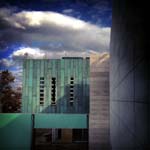 Michael Bongiorno The copper-clad exterior of the new wing as seen from the special event balcony during construction.  DesignGroup View of the Columbus Museum of Art from Broad Street. The museum’s new wing extends toward Broad Street, enhancing the museum’s presence as part of the city's Discovery District.  DesignGroup The museum’s historic 1931 building, left, is complemented by the pre-patinated copper panels that encase the new wing. Cinematic façades, achieved by installing large windows at either end of the new wing, connect the museum interior to the community.  DesignGroup Aerial view of the new visitor entrance at the northeast end of the museum campus. The glass-enclosed special event space overlooks the sculpture garden and flows into that green space via stairs from the balcony.  DesignGroup A model view of the museum's new visitor entrance indicating lighting strategies and balance of solid to glass materials. 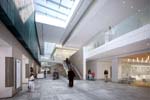 DesignGroup The museum’s new atrium lobby is a welcoming, light-filled space that provides a clear entry and multiple connections between the new wing and existing buildings. Amenities such as the museum store and restaurant are located near the entrance. 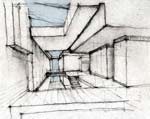 Michael Bongiorno An early sketch explored the opportunities provided by the light-filled atrium between the historic and new galleries, as seen from an upper level bridge. 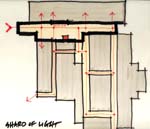 Michael Bongiorno The museum’s new atrium lobby is the project’s central organizing element. Providing entrance, ticketing, and cueing space, it acts as both a connector and a separator linking historic and new galleries.  DesignGroup The permanent gallery space, located on the second floor of the addition, is a long tube of flexible, open space designed to serve the museum's needs well into the future.  Michael Bongiorno An early sketch studied the relationship of building masses among the historic and contemporary wings, as seen from the southeast corner of Broad and Washington Streets.  MKSK Site plan illustraing, clockwise from center-right, the museum’s historic 1931 building, renovated 1970s addition, sculpture garden and entry forecourt, and the newly-constructed linear wing.  DesignGroup An early design diagram shows the linkage of museum event spaces along an axis that leads from arrival at the historic Broad Street entrance to the new sculpture garden. 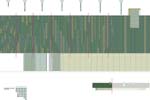 DesignGroup The arrangement of the pre-patinated copper panels encasing the new wing was carefully scripted by DesignGroup in coordination with the manufacturer’s fabrication constraints. 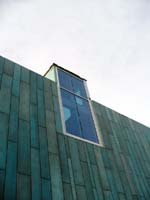 Michael Bongiorno Construction photo of the main clerestory at the upper gallery of the new wing as seen from Washington Avenue.  Michael Bongiorno Construction photo of the Broad Street façade. |
© 2015 ArchNewsNow.com